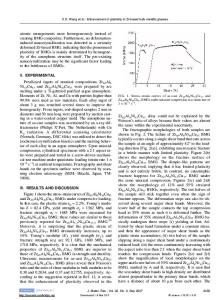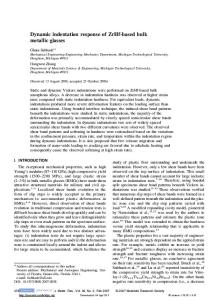Indentation plasticity of amorphous and partially crystallized metallic glasses
- PDF / 241,522 Bytes
- 8 Pages / 585 x 783 pts Page_size
- 101 Downloads / 334 Views
erdier Institut National Polytechnique de Grenoble (INPG), Laboratoire de Thermodynamique et Physico-Chimie Métallurgique (LTPCM), UMR CNRS 5614, 38402 Saint-Martin d’Hères, France
M. Fivel and J.J. Blandina) Institut National Polytechnique de Grenoble (INPG), Génie Physique et Mécanique des Matériaux (GPM2), UMR CNRS 5010, ENSPG, 38042 Saint-Martin d’Hères, France (Received 13 June 2006; accepted 30 October 2006)
Plastic behavior at room temperature of amorphous, partially crystallized, and fully crystallized Zr41.25Ti13.75Cu12.5Ni10Be22.5 Vitreloy 1 samples was investigated using instrumented indentation. Residual imprints were imaged using atomic force microscopy (AFM). Young’s modulus and hardness were estimated using the contact area derived from AFM imaging. It has been shown that the postmortem area measurement is useful to take into account the pileup effect. Indentation experiments performed with a conical tip were associated with parametric two-dimensional axisymmetric finite element modeling using a pressure-sensitive yield criterion. A two-parameter reverse analysis algorithm was used to probe both yield stress and pressure angle. Results showed that the amorphous alloy exhibits a yield stress and pressure angle in good agreement with literature and compressive tests, and that crystallization affects the pressure angle.
I. INTRODUCTION
Bulk metallic glasses (BMGs) exhibit not only unique mechanical properties at room temperature, such as high strength or large elastic domain,1 but also superplasticlike behavior in a viscous state at high temperatures above 0.7 Tg, where Tg is the glass transition temperature.2,3 Thus, BMGs are considered very promising structural materials. However, the mechanical behavior of these materials is often brittle, which limits the field of applications.4 As an example, in standard mechanical tests (i.e., tension or compression), plasticity is generally confined in a very limited number of shear bands, as can be seen on fracture surfaces, which usually exhibit a typical vein like pattern.1 The origin of this localized plasticity and the associated deformation mechanisms are not yet unambiguously established, and nanoindentation is a particularly interesting way to analyze the plasticity due to the confinement of the deformation in a small region.
a)
Address all correspondence to this author. e-mail: [email protected] DOI: 10.1557/JMR.2007.0062 J. Mater. Res., Vol. 22, No. 2, Feb 2007
http://journals.cambridge.org
Downloaded: 29 Mar 2015
The more appropriate yield criterion to be used for BMGs modeling is still under debate. Nevertheless, it is generally admitted that pressure sensitivity has to be taken into account in the yield criterion. Mohr–Coulomb and Drucker–Prager criteria both introduce a positive dependence of the local yield stress to the hydrostatic pressure. The differences between these two models are the same as those between Tresca and Von Mises criteria. Insights on the influence of the hydrostatic pressure on the plasticity developed by
Data Loading...










